If you want to become a successful trader, you need a trading strategy, period! There is no way around it. Without a trading strategy, you will just be buying and selling random assets due to random reasons and that won’t work in the long run. You might make a few profitable trades here and there, but you will never become a consistently profitable trader without a trading strategy.
Instead of trying to develop a trading strategy, many people try to copy someone else’s trading strategy. This, however, is far from ideal. Even if that person is making money with his trading strategy, you might not be able to use his strategy to generate consistent profits for yourself. This is the case because of the following:
- Everyone is different and your strengths and weaknesses may significantly differ from that person’s strengths and weaknesses. His/her strategy is likely designed to fit his/her personal preferences perfectly. But it likely won’t be an ideal fit for you.
- Furthermore, that person has probably spent years upon years developing and refining every detail of his/her strategy. It is almost impossible for him/her to explain every single detailed aspect of his/her strategy to anyone.
Therefore, my suggestion is to build a knowledge foundation and then to develop your own trading strategy that works for YOU and YOUR strengths/preferences (of course, this strategy can be inspired by someone else’s approach to the markets). In this article, you will learn how to develop a trading strategy that actually works! You will learn how to identify real, proven opportunities to generate profits with a strategy that is the perfect fit for you and only you.
Before I start, here is a short disclaimer: I want you to read this guide in an open and honest way. Please try to be honest with yourself for your own sake. To help you do this, I want you to answer the following questions as honestly as you possibly can:
- Do you currently have an actual trading strategy that clearly guides you through every single trading decision?
- Are you basing any of your trading decisions on gut feelings or on a random configuration of technical indicators?
- Are you copying someone else?
- Are you sometimes in a position and aren’t sure what to do next?
If you answered yes to any of the questions 2-4 and/or no to question 1, you don’t have a trading strategy. So listen up and read this guide carefully!!!
But even if you currently have a trading strategy, this guide can help you significantly improve your current strategy.
Be realistic
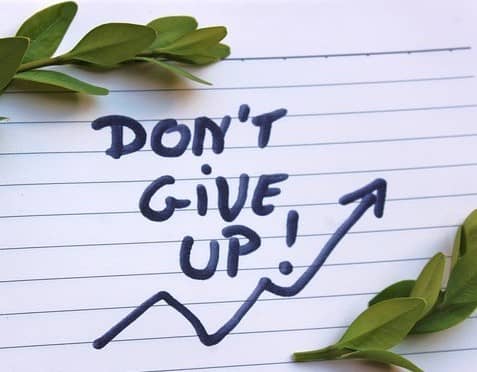
When trying to develop a trading strategy it is very important to have the right expectations. First of all, you have to understand that building a profitable trading strategy is no easy task and it is certainly not a short process. It takes time, dedication, motivation, and work… If you aren’t willing to put in some sweat equity, then don’t even bother.
Furthermore, don’t expect to build an insanely profitable trading system that generates 1000s percentage returns. Try to be as realistic as possible!
I am not saying this to discourage you. I just don’t want you to approach this with the wrong mindset as that could lead to a lot of disappointment. But here are a few words of encouragement:
If you put in the time and actually manage to develop a consistently profitable trading strategy, it could easily replace a full-time job or at least act as a supplementary stream of income! In other words, it will be well worth it in the long run. So don’t give up!
Video Breakdown of How to Develop a Trading Strategy
The following video walks you through all the necessary steps to take in order to develop your own trading strategy:
How to approach developing a profitable trading strategy
It is essential to approach developing a profitable trading strategy in a professional manner. Otherwise, you won’t get professional results.
You might think, you could just go to some charting platform and watch a few stocks and thereby find a profitable trading strategy.
Let me tell you, if that is your approach, you won’t come very far! Approach this just like you would approach a big new project at your job.
I highly recommend using the scientific method when developing a trading strategy. Think of yourself as a scientist that is trying to find a cure for some serious disease. You can’t just randomly mix different chemicals and thereby stumble upon the cure.
So let me introduce you to the scientific method (if you aren’t familiar with it already). The scientific method consists of 5-6 steps:
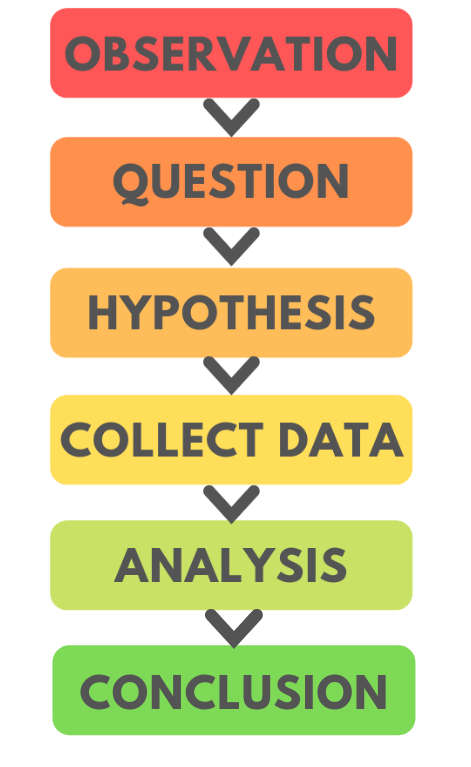
- Observation: You observe something. Trading example: After three (or more) major green days, certain stocks tend to have a big red day.
- Question: You ask a question based on the observation. Trading example: Is the big red day after multiple major green days predictable and if so, how can I take advantage of it?
- Hypothesis: You form a proposition that tries to explain the observation and tries to answer the question. Trading example: The first green-to-red move after 3 or more major green days signals a reversal.
- Collect Data/Experiment/Test: Here you collect data (by experimenting) that either confirms or disproves the hypothesis. The more data you collect, the better. Trading example: You track how certain stocks behave after 3 or more major green days.
- Analysis: You analyze the collected data. Trading example: You order the data tracked and analyze it (identify patterns, anomalies etc.)
- Conclusion: You draw a conclusion that tries to answer the initial question and evaluates the hypothesis. Trading example: The big red day after multiple major red days is predictable and a fast red-to-green move could be used as a reliable entry signal for a short position.
Depending on the conclusion, you might want to start over again with a different (observation), question, hypothesis…
The reason why it is so important to use the scientific method when developing a trading strategy is that it allows you to identify and find a real, proven edge in the markets. You might ask yourself what I mean with a real, proven edge. To answer that, I want you to look at my definition of a trading edge:
Something predictable that can be taken advantage of reliably and on a consistent basis.
If it isn’t predictable, you can’t take advantage of it and therefore, can’t build a trading strategy around it. Furthermore, you have to be able to take advantage of it reliably and on a consistent basis. For instance, if something is predictable but only happens once, I would not consider it a trading edge that should be used to developing a trading strategy.
The edge is what sets you and your trading strategy apart from everyone else (and their strategy). It is by far the most important component of any trading strategy. Without an edge, your strategy won’t be profitable!
An edge is what makes casinos rich. No casino would ever operate without their real, proven, statistical edge and NEITHER SHOULD YOU!
The components of a winning trading strategy
Now I want to walk you through the elements that every winning trading strategy needs. For you to better understand the roles of the different elements, I created the following ‘diagram’:
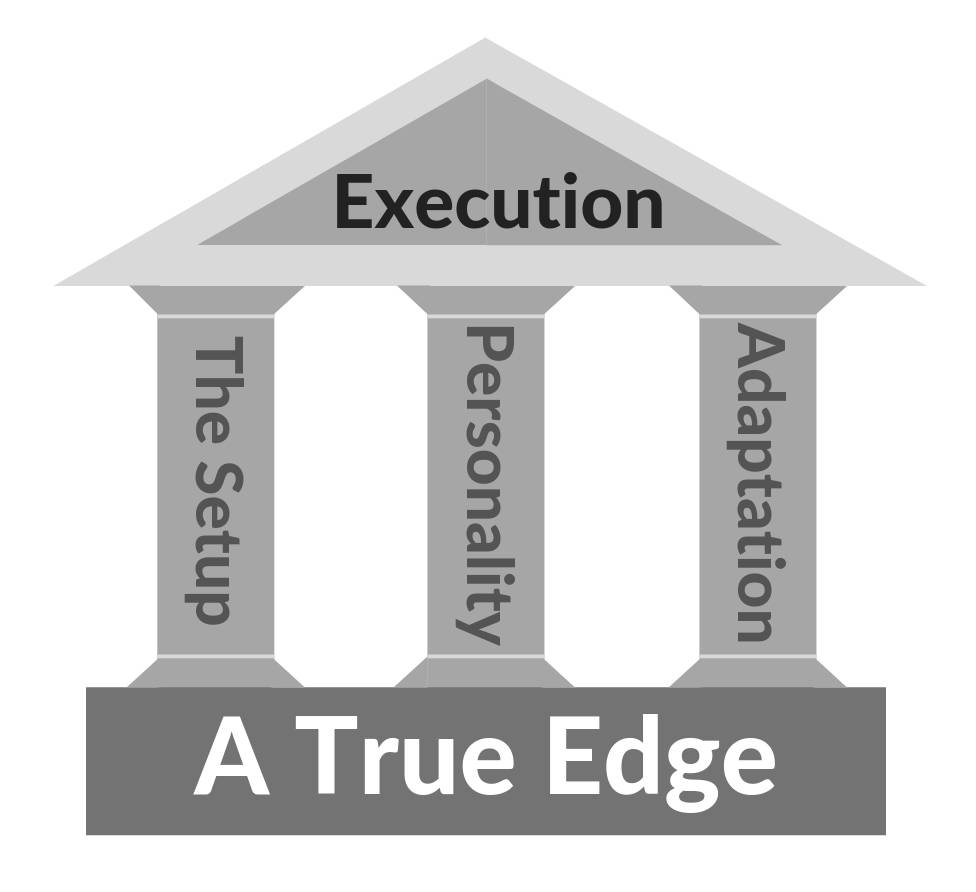
The structure of this ‘building’ is practically identical to that of a profitable trading strategy. It consists of a strong fundament that supports the entire thing. On that fundament, there are several pillars that support the roof. If one of these things would be missing, the entire thing would either be incomplete or even fall apart. The same is the case for a good trading strategy. I will now walk you through every part and explain you its significance.
The Fundament: A True Edge

Your entire trading strategy will be based on this fundament. If your edge isn’t solid, everything will collapse. Therefore, I recommend spending most time perfecting this component of your trading strategy.
A true edge is an actual statistical edge that can be proven through backtesting and forward-testing. By that I mean, you could (and should) look at history to see if historically speaking, this edge was, in fact, an edge and could be used to generate consistent profits. Furthermore, the edge should also continue to work in the future. To find out if it still works, you track it. Remember the fourth step of the scientific method: collect data. Never stop collecting data about the edge to see if it still exists.
Here is a simplified example of an edge (note that this is not necessarily a true edge):
80% of the time implied volatility overstates actual historical volatility.
If that statement is true, it would mean that option’s prices are also overstated 80% of the time (because implied volatility is one major part of option’s prices). This means that you could take advantage of this edge by trading certain short options strategies (as you are collecting ‘too much’ premium for them).
If that was too complicated for you, don’t worry. Here is an easier, even more simplified example of an edge (once again, I am not claiming that this is a true edge):
Stocks under $10 drop 30% or more, 75% of the time after three or more major green days.
If this were the case, you could consistently profit from the down-move by developing a strategy with limited risk that takes advantage of the bearish price action.
Note that in reality, you have to be much more specific and find more criteria to narrow down your edge.
I am aware that this trading edge might seem like a rather abstract thing right now. That’s why I want to give you an easy example that isn’t necessarily trading related:
Think of a simple coin flip game. The odds of picking the right side (heads or tails) is 50%. This means over the long run, you will be right about 50% of the time. Now let’s say, if you pick the right side, you will make $20. But if you pick the wrong side, you only lose $10. In this game, you have a real statistical edge. After 100 rounds of this game, the expected outcome would be that you made $500 (50 × $20 – 50 × $10).
One important characteristic about statistical edges is that they work best in the long run. For instance, if you played one round of the just-described coin flip game, you could easily lose. However, if you play hundreds or even thousands of rounds, the likelihood that you will have made money is very high. This is due to the law of large numbers which states that the greater the number of occurrences, the closer the expected outcome will become to the actual outcome.
The First Pillar: The Setup
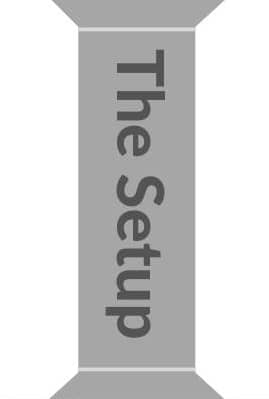
The setup is another important element of a winning trading strategy. The setup is what helps you identify your edge. The more concrete and objective it is, the better. The setup could be a chart setup, but it could just as well be something completely different.
I think this is once again best explained with a brief example. When talking about a trading edge, I mentioned this as an example:
Stocks under $10 drop 30% or more, 75% of the time after three or more major green days.
In this case, the setup would be:
A stock under $10 that had three or more major green days.
This would mean that every time, you see a stock under $10 that had three or more major green days, you want to be ready to take advantage of the likely price drop.
Note that in reality, the setup should be much more specific and objective. For example, ‘major green days’ is a pretty subjective indicator. What is a major green day? Ideally, this should be defined very specifically. In addition to that, further specifications/indicators are a good idea as well (e.g. market cap, volume, technical indicators, the overall market, the long-term chart, fundamentals etc.).
Your entry signal will largely be based on the setup. Therefore, it is very important that it is specific and objective. Another reason why it should be very concrete is that you will use the setup to track your edge. Every time you see a certain setup, track it and find out if there is an edge that can be taken advantage of.
The Second Pillar: Personality/Preferences

Besides the setup, it is just as important to consider your personality and personal preferences. Everyone is different and has different strengths and weaknesses. It is essential to develop a trading strategy that is designed to fit your personal preferences and your strengths.
To drive this point home, I want to present you a few examples:
- If you have a $10 000 trading account, your strategy must be adjusted to be suitable for such an account size. You could not trade a strategy that requires millions of Dollars in that account.
- If you have a full-time job and can’t monitor the markets very frequently, you can’t trade a strategy that requires you to do that.
- If you prefer having a lot of time to make important decisions and really can’t handle a lot of time-pressure, your strategy shouldn’t be a very short-term trading style that requires you to make significant decisions within split-seconds.
- …
I hope these examples help you understand why it is important to design a strategy that fits you, your personal preferences and your strengths.
The Third Pillar: Adaptation/Refinement

The final pillar is adaptation and refinement. The world and with it the markets are constantly evolving and changing. Therefore, your strategy should continually be adapting to the changing market conditions. You should always be trying to improve and refine your strategy.
A trading strategy is never perfect. You can always find certain aspects that could be improved. So continue to track your progress and thereby try to identify aspects that have changed or could be improved.
Of course, you should not significantly change any aspect of your trading strategy on a trade to trade basis. Only make changes based on a large enough set of data that you have analyzed thoroughly (the scientific method)!
The Roof: Execution
This is where everything comes together. Without the roof, your strategy wouldn’t be complete. Ideally, the executions of all your trades should resemble your trading strategy’s edge, the setup, your personality, and potential adaptations.
In other words, your trade execution translates everything else into results. Everything else is the theory, whereas the execution is the practice.
Don’t underestimate the difficulty of executing trades. Even though you should have a specific trading plan for every scenario, actually following your plan and sticking to your trading strategy isn’t easy. This is where psychology comes into play. However, the more specific your trading strategy is, the easier it will be to execute trades and the easier it is to avoid emotional decision making.
Executing trades can be done in a variety of different ways. For instance, you could theoretically automate your entire trading procedure either with automated orders or with trading scripts. But it is, of course also possible to make all trades manually. If you are interested in automated trading, you should check out my article on how to learn algorithmic trading.

I hope you really understand the importance of every component (A true edge, the setup, your personality, adaptation, and the execution). Without the fundament, nothing will work. If the fundament is very weak, it could easily lead to a collapse in the entire building. If one of the pillars is missing, the roof could easily break down. Finally, the roof is what puts everything together. So make sure when you develop a trading strategy that you don’t skip any of these elements!!!
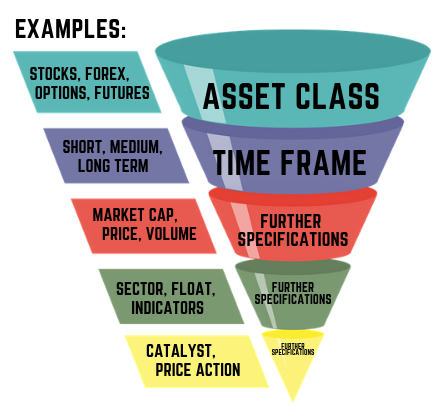
Develop a trading strategy: The Funnel Approach
I mentioned multiple times that it is essential to narrow down your focus to something very specific. The funnel approach will help you with exactly that! It allows you to start out very broad and then (just like a funnel) filter out the vast majority of the original input.
The diagram to the right shows you an example of such a funnel. You start by choosing an asset class such as stocks, forex, options, futures or something else. Then, you decide which time frame you want to focus on. Do you want to day trade, swing trade or even invest? After you chose a time frame, you should further specify what you want to trade. Some examples of further specifications would be: market cap, price, volume, sector, float, indicators, catalyst, news events, price action etc.
I hope you can see how this can help you find your niche. A very common beginner mistake is to try to trade everything. It is very hard to be a successful retail trader over a wide range of different products, sectors, time frames… Therefore, I recommend focusing on one specific area and becoming a master in that niche. Further down the road, you will always be able to expand or even change your niche.
Consistency is key
Consistency is the key to success. If your approach isn’t consistent, you can’t improve and if you can’t improve you will get frustrated very fast. Developing a consistently profitable trading strategy requires you to have a consistent approach.
If your approach changes every time you trade, you won’t have anything to reference to because your last trade had nothing to do with your next trade. So make sure to stay consistent and don’t make too many dramatic changes to your strategy too fast. Make educated decisions based on real data!
If you are struggling with consistency, I really recommend tracking your trades! Tracking your trades allows you to analyze exactly what you are doing and why. That’s how you can find consistency.
The goal of developing a trading strategy
Now let’s discuss your situation after developing a winning trading strategy. How do you know if you have a real trading strategy?
If you can put every single aspect and detail of your strategy to words, you have a strategy! If you have a strategy, put it to words! Write it down on a piece of paper or in a notebook and always have that piece of paper next to you while trading. If you ever are unsure what to do in a trade, you can simply take a look at your notes and that should help you make an educated decision.
Another indicator that shows that you have a trading strategy is the ability to internally visualize the perfect setup. With that, I don’t mean that you can think of a profitable trade. But I mean that you can visualize every single small detail of a very specific setup and you know exactly how to take advantage of that setup.
If that’s the case, you should have no problem taking advantage of this setup the next time you see it in reality.
If you have a real strategy with a real edge, you should also have a much better time avoiding emotions while trading. If you have a true edge, you shouldn’t care about the outcome of a single or a handful of trades because you know that over the long run, you have an edge.
[KiwiClickToTweet tweet=”If you reach this point, you go from being the gambler to being the casino!” quote=”If you reach this point, you go from being the gambler to being the casino!”]
Conclusion
Developing your own winning trading strategy seems like a lot of work, doesn’t it?
That’s because it is a lot of work! But it is what it takes to become a successful trader. I know it might seem overwhelming right now, but remember that becoming a successful trader (or anything successful) is no walk in the park. It is a process that takes time and work!

But if you approach this with the right mindset and are willing to work on developing an ideal strategy for you, the rewards will be well worth it. Just remember that you are a scientist that is trying to find the winning formula. This will take a lot of trial and error, but it is very important not to give up after something doesn’t turn out the way you hoped.
Be professional about it! Every time, you think you failed, you are one step closer to cracking the code!
And even after you cracked the code, don’t stop! Continue to constantly optimize and adapt your strategy to changing conditions.
After you feel very confident with one strategy and have seen very good results with it, you could even consider starting all over again and developing a second trading strategy.
Before I end this article, I just want to tell you that there is no ‘holy grail’ approach to trading. There is no one best strategy. There are hundreds, thousands or even millions of different ways to make money in the markets. But it is all about finding the approach that works for YOU, your preferences, your strengths, the current market conditions etc…
I truly hope you learned a lot and enjoyed reading this guide to developing a profitable trading strategy. If you have any questions, comments or feedback, please let me know in the comment section below!
If you are unsure about how to track your trades, I recommend checking out my Excel Trading Journal Template.

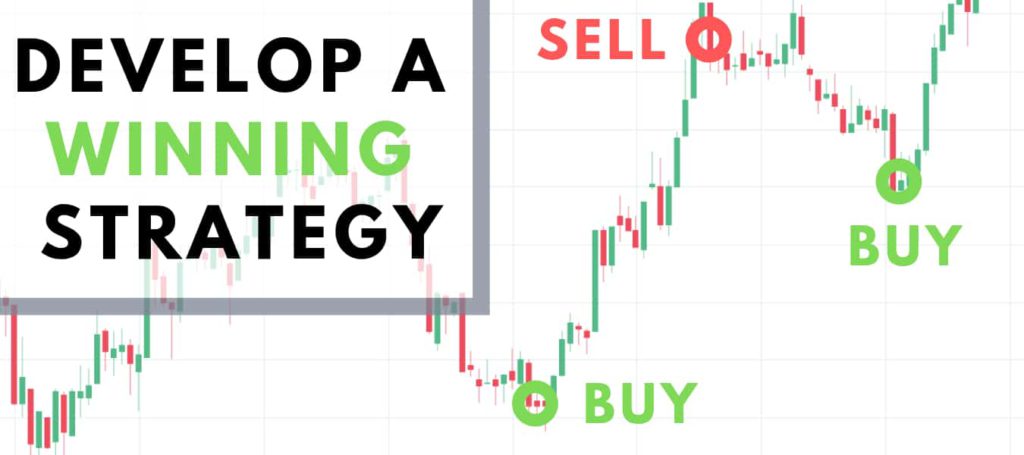
Very instructive article. This is very helpful because we should have the best strategy to win in this game. I was trading one year ago I and saw that it is a big risk but sometimes it is worth it. What do you think about IQ Option trading platform? I really can not find out is it legitimate or not?
Hi Daniel,
Do yourself the favor and stay far away from IQ Option. They aren’t a legitimate broker that offers real trading products. As a rule of thumb, you can remember, if a broker offers binary options, don’t open an account with them. If you want to learn about the details, make sure to check out my review of IQ Option.
I love the fact that you promote a scientific method of developing a strategy. The only time I tried trading I had to get out because I decided that I was too emotional of a trader. What your post pointed out to me was that I really didn’t have a clear cut and/or defined strategy.
That’s right! Trading without a clear plan and strategy is very hard. Controlling emotions is much easier when you know exactly what to do and when to do it.
Louis, I just received an email from TD Ameritrade. They have eliminated all their fees starting October the 3rd except the contract fee on options. It is 65 cents per contract but no exercise fee or assignment fees any more and no fees on equity trades or ETF trades. Isn’t that GREAT!